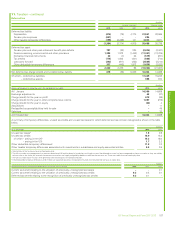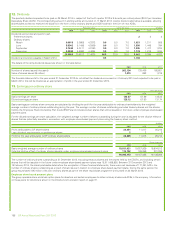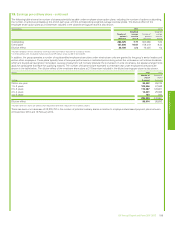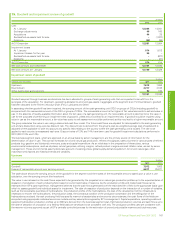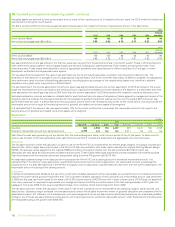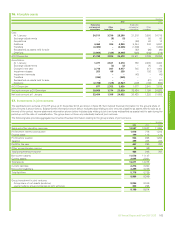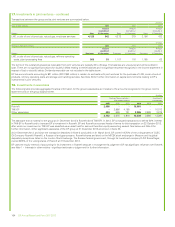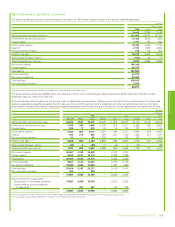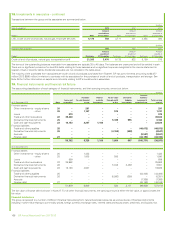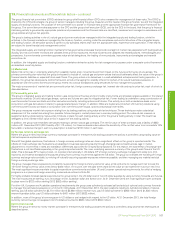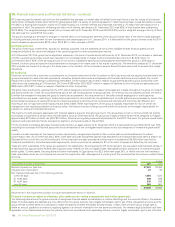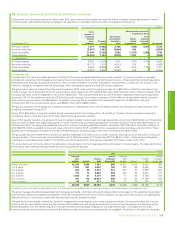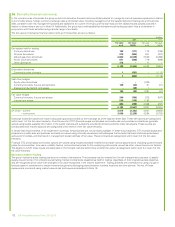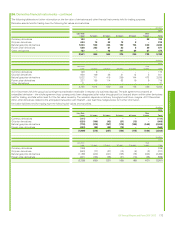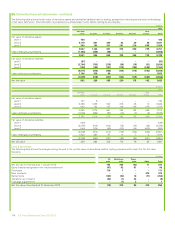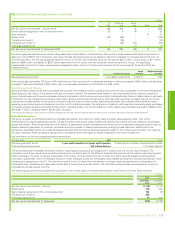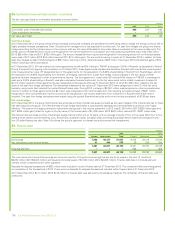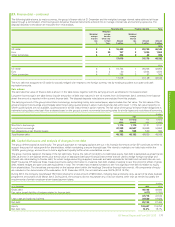BP 2013 Annual Report Download - page 171
Download and view the complete annual report
Please find page 171 of the 2013 BP annual report below. You can navigate through the pages in the report by either clicking on the pages listed below, or by using the keyword search tool below to find specific information within the annual report.
19. Financial instruments and financial risk factors – continued
The group financial risk committee (GFRC) advises the group chief financial officer (CFO) who oversees the management of these risks. The GFRC is
chaired by the CFO and consists of a group of senior managers including the group treasurer and the heads of the group finance, tax and the integrated
supply and trading functions. The purpose of the committee is to advise on financial risks and the appropriate financial risk governance framework for
the group. The committee provides assurance to the CFO and the group chief executive (GCE), and via the GCE to the board, that the group’s financial
risk-taking activity is governed by appropriate policies and procedures and that financial risks are identified, measured and managed in accordancewith
group policies and group risk appetite.
The group’s trading activities in the oil, natural gas and power markets are managed within the integrated supply and trading function, while the
activities in the financial markets are managed by the treasury function, working under the compliance and control structure of the integrated supply
and trading function. All derivative activity is carried out by specialist teams that have the appropriate skills, experience and supervision. Theseteams
are subject to close financial and management control.
The integrated supply and trading function maintains formal governance processes that provide oversight of market risk associated with trading activity.
A policy and risk committee monitors and validates limits and risk exposures, reviews incidents and validates risk-related policies, methodologiesand
procedures. A commitments committee approves value-at-risk delegations, the trading of new products, instruments and strategies and material
commitments.
In addition, the integrated supply and trading function undertakes derivative activity for risk management purposes under a separate control framework
as described more fully below.
(a) Market risk
Market risk is the risk or uncertainty arising from possible market price movements and their impact on the future performance of a business. The
primary commodity price risks that the group is exposed to include oil, natural gas and power prices that could adversely affect the value of the group’s
financial assets, liabilities or expected future cash flows. The group enters into derivatives in a well-established entrepreneurial trading operation. In
addition, the group has developed a control framework aimed at managing the volatility inherent in certain of its natural business exposures. In
accordance with the control framework the group enters into various transactions using derivatives for risk management purposes.
The major components of market risk are commodity price risk, foreign currency exchange risk, interest rate risk and equity price risk, each of which is
discussed below.
(i) Commodity price risk
The group’s integrated supply and trading function uses conventional financial and commodity instruments and physical cargoes available in the related
commodity markets. Oil and natural gas swaps, options and futures are used to mitigate price risk. Power trading is undertaken using a combination of
over-the-counter forward contracts and other derivative contracts, including options and futures. This activity is on both a standalone basis and in
conjunction with gas derivatives in relation to gas-generated power margin. In addition, NGLs are traded around certain US inventory locations using
over-the-counter forward contracts in conjunction with over-the-counter swaps, options and physical inventories.
The group measures market risk exposure arising from its trading positions using value-at-risk techniques. These techniques make a statistical
assessment of the market risk arising from possible future changes in market prices over a one-day holding period. The value-at-risk measure is
supplemented by stress testing. Value-at-risk limits are in place for each trading activity and for the group’s trading activity in total. The board has
delegated a limit of $100 million value at risk in support of this trading activity.
In addition, the group has embedded derivatives relating to certain natural gas contracts. The net fair value of these contracts was a liability of $652
million at 31 December 2013 (2012 liability of $1,112 million). For these embedded derivatives the sensitivity of the net fair value to an immediate 10%
favourable or adverse change in each key assumption is less than $100 million in each case.
(ii) Foreign currency exchange risk
Where the group enters into foreign currency exchange contracts for entrepreneurial trading purposes the activity is controlled using trading value-at-
risk techniques as explained above.
Since BP has global operations, fluctuations in foreign currency exchange rates can have a significant effect on the group’s reported results. The
effects of most exchange rate fluctuations are absorbed in business operating results through changing cost competitiveness, lags in market
adjustment to movements in rates and translation differences accounted for on specific transactions. For this reason, the total effect of exchange rate
fluctuations is not identifiable separately in the group’s reported results. The main underlying economic currency of the group’s cash flows is the US
dollar. This is because BP’s major product, oil, is priced internationally in US dollars. BP’s foreign currency exchange management policy is to limit
economic and material transactional exposures arising from currency movements against the US dollar. The group co-ordinates the handling of foreign
currency exchange risks centrally, by netting off naturally-occurring opposite exposures wherever possible, and then managing any material residual
foreign currency exchange risks.
The group manages these exposures by constantly reviewing the foreign currency economic value at risk and aims to manage such risk to keep the
12-month foreign currency value at risk below $400 million. At no point over the past three years did the value at risk exceed the maximum risk limit.
The most significant exposures relate to capital expenditure commitments and other UK and European operational requirements, for which a hedging
programme is in place and hedge accounting is claimed as outlined in Note 26.
For highly probable forecast capital expenditures the group locks in the US dollar cost of non-US dollar supplies by using currency forwards and futures.
The main exposures are sterling, euro, Norwegian krone, Australian dollar and Korean won. At 31 December 2013 the most significant open contracts
in place were for $723 million sterling (2012 $853 million sterling).
For other UK, European and Australian operational requirements the group uses cylinders (purchased call and sold put options) and currency forwards
to manage the estimated exposures on a 12-month rolling basis. At 31 December 2013, the open positions relating to cylinders consisted of receive
sterling, pay US dollar cylinders for $2,770 million (2012 $2,886 million); receive euro, pay US dollar cylinders for $962 million (2012 $1,636 million);
receive Australian dollar, pay US dollar cylinders for $401 million (2012 $522 million).
In addition, most of the group’s borrowings are in US dollars or are hedged with respect to the US dollar. At 31 December 2013, the total foreign
currency net borrowings not swapped into US dollars amounted to $665 million (2012 $364 million).
(iii) Interest rate risk
Where the group enters into money market contracts for entrepreneurial trading purposes the activity is controlled using value-at-risk techniques as
described above.
Financial statements
BP Annual Report and Form 20-F 2013 167


